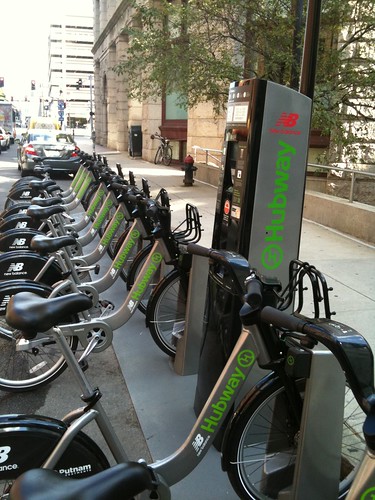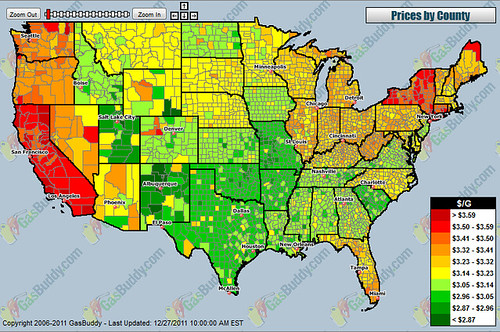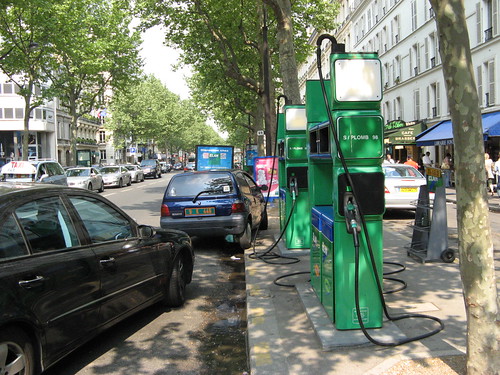|
Special Features





Image Libraries


|
|
Blog
|

Boston’s Hubway. Photo by Luis Tamayo on Flickr. |
2010 was the year bikesharing made it big in the US, with the opening of the first large-scale networks in Denver, Minneapolis, and Washington. That trend continued in 2011, with large new networks in Miami Beach and Boston.
Here are the current US bikesharing systems, ranked by their number of stations. The list is a lot more impressive than last year’s version.
- Washington/Arlington, DC/VA: 140 stations
- Minneapolis/Saint Paul, MN: 115 stations
- Miami Beach, FL: 70 stations
- Boston, MA: 61 stations
- Denver, CO: 52 stations*
- Madison, WI: 27 stations
- Broward County, FL: 20 stations
- San Antonio, TX: 20 stations
- Boulder, CO: 15 stations*
- Washington State University – Pullman, WA: 8 stations
- Chicago, IL: 7 stations
- Omaha, NE: 5 stations
- University of California – Irvine: 4 stations
- Des Moines, IA: 4 stations
- Tulsa, OK: 4 stations
- Louisville, KY: 3 stations
- Kailua, HI: 2 stations
- Spartanburg, SC: 2 stations
Nationwide, the total number of cities with bikesharing expanded from 8 to 18, and the total number of bikesharing stations more than doubled, from 251 to 559.
For the second straight year Washington’s Capital Bikeshare was the largest system, but CaBi will begin to face more serious competition in 2012 and 2013 as a number of new cities begin to launch their own networks. Baltimore is expected to launch with 30 stations next year, Chicago may build up to 300, and most notably of all: New York is moving forward with a 600-station behemoth system.
Data for this list was compiled with the help of The Bike-Sharing Blog’s excellent map of world bikesharing.
* Denver and Boulder are counted separately, but cross-honor memberships. Together they have 67 stations.
 Cross-posted at Greater Greater Washington. Cross-posted at Greater Greater Washington.
Average Rating: 4.4 out of 5 based on 239 user reviews.
December 30th, 2011 | Permalink
Tags: bike, transportation

GasBuddy is an interesting website that tracks the price of gas around the US. Car-free urbanites may not be as affected by gas prices as car-reliant suburbanites are, but hey, cool map.
If you go to the website you can zoom in.

Average Rating: 4.5 out of 5 based on 204 user reviews.
December 28th, 2011 | Permalink
Tags: roads/cars, transportation

|

Image by M.V. Jantzen on flickr. |
Sometimes politicians can delay the construction of otherwise popular projects they don’t support by insisting on more studies before work can begin. In DC, less than one mile of bike lanes were added in 2011. Is this a sign of tepid support for bike lanes from the Mayor or other top officials?
Former Maryland Gov. Bob Ehrlich used a “paralysis by analysis” strategy to stall the Purple Line. To say the Purple Line went nowhere under his leadership would be an understatement. But it was studied a lot. Ehrlich added new routing options, new modes, new timelines… anything to keep it on paper but not moving forward.
Meanwhile, he fast-tracked the ICC through the planning process in record time.
It’s a great solution for politicians. You’re not actually canceling anything and risking re-election. You’re just waiting for more information to come in, so you can make an informed decision. Who could possibly be against that?
Bike lane striping under the Gray administration has ground to a halt. Almost none of the promised 2011 additions to the bike network were delivered. And while DDOT promises to stripe new bike lanes as soon as the weather warms up, they are clearly falling behind.
Meanwhile, the most significant proposed bike projects, the L and M Street cycle tracks, remain mired in study. DDOT has said it won’t commit to building them until it has completed a study of the existing 15th Street and Pennsylvania Avenue cycle tracks. That’s a little odd, because DDOT already completed a similar study in 2010. Why do we need another one to tell us the same thing? And how long is this study supposed to take? It’s already been six months.
No doubt Mayor Gray hears a lot about bike lanes. It must seem that half of his constituents want more of them, and the other half don’t want them at all. Putting off the decision in order to avoid upsetting anyone must be a tempting solution. It’s hard to know for sure, but the longer these studies drag on, the more likely this possibility seems.
But the delay-by-study strategy can only work for so long. Ultimately voters in Maryland saw through Ehrlich’s Purple Line scheme, and it contributed to his defeat by Martin O’Malley.
When Gray was elected I said we should give him a chance to prove that he really will continue urbanist policies. After one year, the jury is still out. It is still too early to judge him. It is still too early to conclude that he is trying to study the cycle tracks out of existence. But if he hasn’t decided to build them in another six months or so—a year after the study began—then we’ll have our answer.
 Cross-posted at Greater Greater Washington. Cross-posted at Greater Greater Washington.
Average Rating: 4.4 out of 5 based on 175 user reviews.
December 23rd, 2011 | Permalink
Tags: bike, government, transportation

Two years ago I wrote that DC cabs should be iconic. With such a large fleet of taxis, but without a uniform livery for them, we are losing an opportunity to extend the city’s brand recognition. After all, New York’s yellow taxis are a strong symbol of that city. With a uniform color scheme ours could be too.
And so I’m very pleased to see exactly that provision included in the latest round of proposed taxi legislation. It isn’t a done deal, but it’s a good step forward.
So, what color should the city pick? Yellow is too readily identified with New York. White and black are probably too bland to become iconic. There is a petition floating around to select red, which would be very appropriate. Not only is red the “city color, ” it’s also the color of the Circulator buses, local WMATA buses, and Capital Bikeshare. Tying together all our transportation modes with a unified color scheme would be very strong branding.
This is a simple and common sense thing that will benefit the city for decades. If we give taxi operators a comfortable timeframe in which to make the change, it shouldn’t be too great a burden on them. Let’s do it.
Average Rating: 5 out of 5 based on 158 user reviews.
December 20th, 2011 | Permalink
Tags: roads/cars, transportation

|

|
Last week The Atlantic – Cities published an article discussing what DC would be like if our Metrorail system had never been built. If you haven’t read it yet, it’s worth a look.
The piece of their article that really stands out to me is this graphic, which shows the area of downtown DC that would have to be converted to parking garages in order to store all the extra cars that would come downtown, if not for Metro. That’s parking garages, not surface lots.
Can you imagine this? It’s more than half of downtown! It’s an absolutely huge area. And never mind all the additional roads we’d need to get those cars in and out. If we needed this much parking, it would destroy our city. We wouldn’t have a city. We’d have Tysons Corner, which everyone hates and to which Fairfax County is now adding Metro in a desperate attempt to fix.
But we’re lucky. We avoided this tragedy. Most other American cities didn’t. Most other American cities did this.
And the real shocking thing is there are still misguided souls out there who think our cities would be better if we tore them down.
Average Rating: 5 out of 5 based on 155 user reviews.
December 19th, 2011 | Permalink
Tags: roads/cars, transportation, urbandesign

How do you incorporate gas stations into the urban environment without hurting walkability or dismantling the street wall?
Here’s an idea from Paris: Put it on the sidewalk.

This particular example is on a median separating local lanes from the main lanes, like K Street,
but the concept might just as easily work on regular streets too.
Photo by brunoboris on flickr.
Average Rating: 4.4 out of 5 based on 272 user reviews.
December 16th, 2011 | Permalink
Tags: roads/cars, transportation, urbandesign

The federal government’s latest round of TIGER grants have been awarded. The list of winners shows that the only DC-region grantee is VDOT, who received $20 million to leverage a TIFIA loan for HOT lanes on I-95.
The regional request for bike/ped improvements to rail stations was not funded. The reason appears to be that bike and ped projects in general are big losers in this round. Only a single dedicated bike/ped project is on the winner list, a small $1 million project to add a separated pedestrian crossing over a busy state highway in Minnesota. Even it appears to be as much about getting pedestrians out of car’s way as it is about helping peds.
Here is the break down of the award winners, by type:
- Port and freight: 10 grants awarded.
- Highway: 12 grants awarded.
- Transit: 10 grants awarded.
- Complete streets: 6 grants awarded.
- Bridges: 6 grants awarded.
- Signalization project: 1 grant awarded.
- Bike/ped: 1 grant awarded.
Several of the projects that are primarily other modes do contain bike/ped facilities. For example, Chicago received a $20 million grant for track reconstruction of its Blue Line, which included money for expansion of Chicago’s tiny bikesharing system. Another example is Stamford, CT, which received $10.5 million for improvements to its commuter rail station that include some bike/ped facilities. And of course there are 6 complete streets projects.
So while bikes and peds aren’t absent from the grants completely, it does appear that the only way to make improvements for them under this year’s program was to bundle them with bigger projects.
Transit awards
Although the DC area didn’t win any awards for transit, some of those 10 transit grants are pretty exciting. Here they are:
- Stamford, CT: $10.5 million for rail station improvements.
- Charlotte, NC: $18 million for longer platforms at three Lynx light rail stations.
- San Antonio, TX: $15 million for a new downtown transit center.
- Dallas, TX: $5 million to support a TIFIA loan to complete the Orange line light rail extension to DFW Airport.
- Chicago, IL: $20 million for track rehabilitation on the el Blue Line, and for bikesharing.
- Alton, IL (suburban Saint Louis): $14 million for a new downtown rail station.
- Cleveland, OH: $12.5 million to reconstruct the Mayfield Red Line station.
- Cincinnati, OH: $11 million for the Cincinnati streetcar.
- Minneapolis, MN: $10 million for a new platform at the Target Field light rail station.
- Seattle, WA: $10 million to extend Seattle’s airport light rail line to a new terminal station further south.
Average Rating: 4.5 out of 5 based on 241 user reviews.
December 15th, 2011 | Permalink
Tags: government, transportation

|

One of the only photos of 19th Century bloodletting known to exist. Public domain image from Wikipedia. |
Before the rise of modern medicine, doctors all around the world practiced something called bloodletting. The basic idea was that illnesses were caused by bad blood, which had to be removed. A whole profession rose up around the theory and practice of bloodletting. It dominated medicine for generations.
But there was a problem: People who should have been getting better after bloodletting kept dying. George Washington is the most famous example. On the day he died, enough blood was intentionally removed from his body to fill a 12 pack.
As the 19th Century rolled on, humanity’s grasp of science improved and we eventually learned that removing large amounts of blood weakens patients and doesn’t treat most illnesses. Rather than helping people, bloodletting actually made them worse. Doctors who were trying to help people had actually been murdering them.
In short, the fundamental theory behind bloodletting was completely wrong.
Sound familiar? It’s a lot like 20th Century traffic engineering. At the advice of traffic engineers, America spent the latter half of the 20th Century building larger and larger roads in order to relieve congestion, which only got worse and worse with every subsequent enlargement. We rebuilt our civilization around universal car use, and then discovered that when everyone is forced to drive everywhere for everything it actually reduces our mobility.
Oops.
And so, as the 21st Century chugs along, more and more people are calling into question the ridiculous tools of traffic engineering, and no longer giving the profession carte blanche to design our infrastructure. Traffic engineers, as a result, are finding themselves increasingly marginalized. Those who cannot or will not evolve away from what they learned in the 20th Century are being gradually stripped of their respected authority.
In an interesting oped to the Engineering News-Record, traffic engineer Sam Schwartz discusses this increasing marginalization, and calls upon traffic engineering to progress as a profession. He decries the mentality that cars are “real transportation” and anything else is “alternative transportation, ” and cites easy-to-understand mathematical facts supporting multimodalism.
If we are going to function as a technologically advanced civilization then we need transportation engineers. Street design is a difficult and complicated proposition, and requires a professional touch. The good news is that many traffic engineers are beginning to see the light, and move away from the archaic dogma of the 20th Century.
Average Rating: 4.6 out of 5 based on 249 user reviews.
December 13th, 2011 | Permalink
Tags: history, roads/cars, transportation

Animals are smarter than we give them credit for. They know roads are dangerous to cross, and know how to avoid doing so.
According to a study by the University of Maryland, almost 60 different species of animals have been spotted using underground drainage culverts to safely cross roads. Not only do they use the tunnels, they also show preferences regarding tunnel design, and teach their young how to use the tunnels safely. Deer avoid tunnels with rocky floors, herons like tunnels big enough to flap their wings in, and just about all the observed species like tunnels with unobstructed views.
The study used motion-capture cameras to photograph thousands of animals using the tunnels. A few examples are reproduced below. They clearly show why this behavior is as beneficial to humans as it is to animals: no car driver wants to hit a giant horned buck or a stinky skunk.
Average Rating: 5 out of 5 based on 205 user reviews.
December 12th, 2011 | Permalink
Tags: environment, galleries, transportation, urbandesign

I’m in Norfolk at the Virginia Governor’s Transportation Conference the rest of this week and therefore probably won’t be blogging. I will be on Twitter if anything interesting happens.
Average Rating: 4.5 out of 5 based on 225 user reviews.
December 7th, 2011 | Permalink
Tags: site

|
Media





Site
About BeyondDC
Archive 2003-06
Contact
Category Tags:
Partners
|

 Cross-posted at Greater Greater Washington.
Cross-posted at Greater Greater Washington.




















